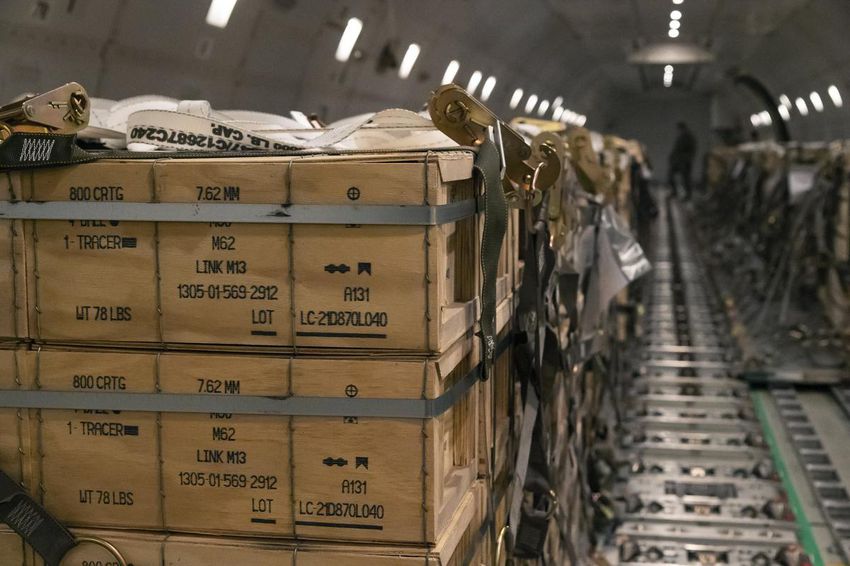Cannons, tanks, missiles, bullets and guns.
A mass of deadly metal — particularly brutal, heavy weaponry — is on its way east. This is what Ukraine has been begging for since the Russian invasion began. Finally, in the third month of the war, western nations are starting to respond.
Howitzers and helicopters, anti-air systems and armored vehicles, tank-piercing missiles, shells, grenades and drones — all of it offered up at a sort of donors’ meeting attended by about 40 countries Tuesday at the US Air Force base in Ramstein, Germany.
Some of it is being pulled from storage and dusted off for deployment to the Ukrainian frontlines. Some of it, like the eight armored vehicles on offer from Canada, is to be purchased new and sent directly to a friendly country in need.
It matters little, said Ukrainian Defense Minister Oleksii Reznikov, so long as it can be used to repel Russian forces.
“Every tranche of military assistance brings us closer to peace in Europe, strengthens security in the world, reinforces justice and our joint victory over Russia,” he wrote in a tweet from the meeting.
Just as important as what these weapon shipments can do in the hands of Ukrainian soldiers defending their country is what they say about the determination of the pledging countries, says retired Canadian Lt.-Gen. Andrew Leslie.
“The president of Ukraine has been asking for tanks and anti-aircraft systems and anti-tank systems … from the beginning,” Leslie told the Star. “It’s just that now NATO is saying that we now realize and recognize that Putin may not stop.”
It’s a realization based on a dangerous calculation.
Part of the reason for the western world’s reluctance to roll out the big guns early in the war was a fear that it would be seen as an escalation likely to provoke Russian President Vladimir Putin.
Ahead of the invasion, Washington and Moscow spent months arguing over Russia’s demand to roll back the steady eastward expansion of NATO, which Russia perceived as an existential threat.
Canada’s military assistance, for example, went from with body armor and night-vision goggles in early February, to rifles, machine-guns and ammunition on the eve of the Russian invasion, to the Howitzer cannons and thousands of shoulder-launched anti-tank weapons that Defense Minister Anita Anand announced Tuesday.
Canada can be more generous, said Leslie. It must be, if Canada hopes to emerge from this crucial moment in history with its reputation as a military force and world leader in tact, he said.
“We could be doing more, but at least we’re now sending heavy stuff,” he said.
The headline offer of the day was from Germany — 50 anti-aircraft tanks, putting to bed its historical reluctance to fuel conflict nearly eight decades after its own aggression spread war across the world.
The West is now showing greater determination despite the haunting potential of a nuclear mushroom cloud hanging over the whole affair.
In mid-March, the Americans had nixed a Polish offer that would have seen two dozen MiG-29 fighter jets transferred to US custody for delivery to Ukraine, whose air force flies the same Soviet-era combat aircraft. The risk to American pilots was deemed too high, but just as dangerous was the possibility a nuclear-armed Putin would see the offer as an escalation, senior US Defense officials said at the time.
But when Slovakia’s prime minister suggested earlier this month that it could provide Ukraine with its fleet of MiG-29s, the US expressed no objections, though said it was not party to any such deal.
Ukraine’s demand for fighter jets is the one big ask that has so far gone unanswered by the West, though this may have something to do with the fact that the country’s air force uses aging jets flown almost exclusively by a limited number of eastern European nations.
In most other ways, Ukraine’s western backers have done away with the usual diplomatic niceties and caution.
Sixteen Soviet-era Mi-17 helicopters the US is providing to Ukraine were actually purchased in 2013 from Russia for use in Afghanistan. In the contract was a clause prohibiting their sale to a third party without Moscow’s consent, Russian Foreign Minister Sergei Lavrov said in a televised interview with Russia’s Channel One this week.
“Sending these helicopters to Ukraine is a direct violation of obligations in a very important area of international relations,” Lavrov charged.
But it would seem that, at this moment, a breach of contract pales in comparison to Russia’s alleged war crimes, its aggression, its so-far unceasing escalation.
“Sanctions didn’t stop him, and it won’t stop him. In my opinion, he is determined to get the whole of Ukraine and there’s no guarantee he’s going to stop there,” Leslie said.
“What Putin is doing is a tectonic shift. Just like COVID was for international health, so are Russia’s actions — except that they are an order of magnitude more dangerous. If we miscalculate or Putin miscalculates, we could all die.”
JOIN THE CONVERSATION
